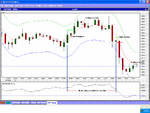Morning all,
I've been playing around with various moving average strategies over the last few weeks with a view to developing a simple intraday strategy that will return 10-20 points on each trade. The DOW seems to be the obvious market given the large daily range and good volatility.
So here goes, I'm using ADVFN streaming charts for my signal (30 minute chart) with the MA Envelope overlay (5 period, deviance 0.3). I avoid any trades around data announcements and generally do not enter within the first 30 minutes.
Once the trend is clear as dictated by the direction of the MA, I wait for the price to head towards the upper or lower channel and then pullback to the MA. I enter when the price continues in the direction of the trend towards the upper or lower channel and aim for 10-20 points (target dependent on the size of the preceding price bar).
I've not been able to back test this but looking through the last few weeks charts it certainly looks promising. The obvious place for a stop seems to be just below the MA but am open to suggestions.
All suggestions/comments are welcome.
I've been playing around with various moving average strategies over the last few weeks with a view to developing a simple intraday strategy that will return 10-20 points on each trade. The DOW seems to be the obvious market given the large daily range and good volatility.
So here goes, I'm using ADVFN streaming charts for my signal (30 minute chart) with the MA Envelope overlay (5 period, deviance 0.3). I avoid any trades around data announcements and generally do not enter within the first 30 minutes.
Once the trend is clear as dictated by the direction of the MA, I wait for the price to head towards the upper or lower channel and then pullback to the MA. I enter when the price continues in the direction of the trend towards the upper or lower channel and aim for 10-20 points (target dependent on the size of the preceding price bar).
I've not been able to back test this but looking through the last few weeks charts it certainly looks promising. The obvious place for a stop seems to be just below the MA but am open to suggestions.
All suggestions/comments are welcome.


